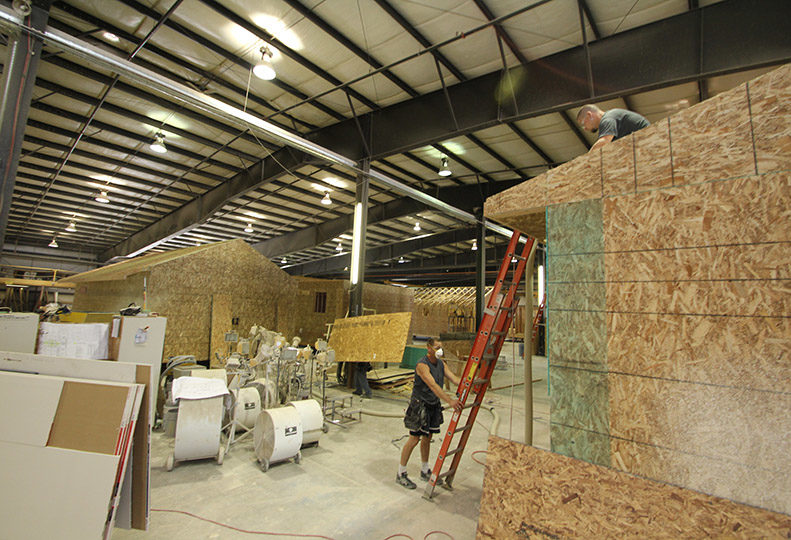
Home » Modular builder taps new markets
Modular builder taps new markets
Stratford starts to take on more commercial projects than single-family homes

July 18, 2013
Stratford Building Corp., of Rathdrum, which operates a 55,000-square-foot factory complex, expects 2013 to be a banner sales year after having gained footholds in new construction-market sectors during the recession, says John Davis, the company's vice president and general manager.
Before the recession, the company was a prominent producer of factory-built homes serving the Pacific Northwest. Now the majority of its production is for commercial and public-sector applications, including banking, retail, lodging, multifamily housing, assisted-living, office, and educational uses.
"We've changed significantly in the last five years," he says. "We still do single-family homes, but we have a new business model, and we're doing more project-based work."
The company currently has 71 employees—up from 40 a year ago, Davis says.
"That's the highest number of employees we've had in the 13 years I've been here," he says.
In addition to carpenters, equipment operators, and laborers, Stratford's staff includes project coordinators, designers, procurement professionals, electricians, and plumbers.
"All trades are employed in-house," he says.
Davis says he expects the company's revenues for 2013 will exceed $12.5 million.
That would surpass its 2006 volume, its last high sales year that topped $10 million. By 2009, annual sales had dropped by two-thirds from their peak level, Davis says.
"It was the worst housing recession since the Great Depression," he says.
By 2009, Davis, who has a background in commercial construction, had begun implementing a plan to steer Stratford into commercial, or project-based, market sectors.
Stratford survived on pubic-sector projects, many of which were funded through federal stimulus dollars, he says. One of its first stimulus projects involved manufacturing structures to be used as remote barracks for the U.S. Forest Service.
As the economy has begun to emerge from the recession, Stratford's commercial and public-sector work has built up progressively in value, starting with $400,000 to $600,000 projects.
The company's highest-value project to date is a $4.5 million, 104-room college dorm complex, which currently is being transported via barge to Alaska. The value includes $2.2 million for construction, $1.7 million for transportation, and the rest for work in the field.
Stratford loaded the components of the 25,000-square-foot structure onto a 400-foot barge in Lewiston last week. The structure is being shipped in 39 pieces, called modules.
A module is a portion of a structure that can be trucked to a construction site. A full-sized module typically has 900 square feet of floor space, Davis says.
At the company's factory, which is situated on 20 acres of land at 7628 W. Boekel, structures are built in an assembly line setting, starting with the floor frame. Walls and interior features are added as the module is rolled on industrial-sized casters through succeeding assembly stations in the factory.
On average, it takes 12 to 14 working days to complete a module, and up to 20 modules can be in various stages of production at the factory at any one time.
Once a module is delivered, it takes about three to four hours to set it on a foundation using a crane, and it typically takes three to four weeks to complete the module work at the site, Davis says.
"There's always a balance between factory and on-site construction," he says.
For the Inland Northwest market, Stratford has two homes on display next to the factory. One display home is a 1,600-square-foot, ranch-style house, and the other is a larger, multilevel Northwest lodge-style home.
Davis says the homes are priced competitively in a multitiered system that varies depending on whether the homebuyer has Stratford or an independent builder perform site work and deliver the structure.
Factory-built homes usually have the biggest price advantage in rural and semirural areas, where securing building materials and subcontractors tend to be more expensive and time consuming, he asserts.
For commercial structures, the largest advantage to buyers is that factory-built projects can be completed faster than on-site construction, he says.
"The time to occupancy is accelerated," Davis says. "Instead of a project lasting nine months, we can do it in four months."
Outside of the Inland Northwest, Stratford's customers tend to be contractors and developers, rather than end users.
Stratford's main territory includes Washington, Idaho, Montana, Oregon, Wyoming, and Alaska, and the Canadian provinces of British Columbia and Alberta. Davis says sales in British Columbia and Alberta fared comparatively better than U.S. sales during the economic downturn.
"Canada has different lending practices, and the Canadian dollar has been about par with the U.S. dollar," Davis says. "That's been favorable to us."
Today, sales in Canada make up 20 percent of the company's revenues, he says.
The company has a three-month backlog of projects in the pipeline. "Business looks favorable into October," he says.
Stratford currently is constructing a 12-module, four-unit town house project at the factory for a Colorado developer. Next up, it will construct workforce housing destined for the North Dakota oil fields.
The company is able to take on projects year-round, although work slows down in February, March, and April, usually due to on-site conditions.
"As long as you have foundations in the ground before the frost sets in, you can set buildings at any time," Davis says.
Stratford Building Corp. opened its Rathdrum factory in 1994. The company is a spinoff of Stratford Homes LP, of Stratford, Wisc., a modular homebuilder that serves the Midwest states.
Special Report
Related Articles





